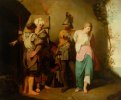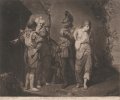'Washing it's hands' does not excuse its inaction!!!Small comfort, Tree. But the execution was done by the secular authority. After condemnation - or abjuration - the Church "washed it's hands" of the matter and the poor women were sent to a terrible death by someone else.
-
Sign up or login, and you'll have full access to opportunities of forum.
You are using an out of date browser. It may not display this or other websites correctly.
You should upgrade or use an alternative browser.
You should upgrade or use an alternative browser.
Erotic helplessness : a study of the history of the Damsel in Distress theme in art
- Thread starter coldturkey
- Start date

Of course. From about the 12th century (Cathars in France) to the end of the 15th century & earlier 16th (Reformation) and to sometime in the 17th (end of the Thirty Years War?), the Church was determined to destroy dissent both within and outside the Church's remit. The Church also took the lead in countering the influence of "witches and wizards" (along with plenty of Protestant princes and authorities).'Washing it's hands' does not excuse its inaction!!!
Should the Church have shown Christian mercy? Yes. However, like all humans running institutions established by other humans, those in control saw their interests under attack, and they established an institutional regime to secure those interests. The Inquisition and the civil laws against witchcraft had little or no reverence for their victims - overwhelmingly women. It was mostly about domination and controlling women's bodies - even unto their deaths. Those in power very often had blood on their hands, and for centuries.
Eva Inanna
Governor
Blood is a sacred and powerful symbol for the Catholic Church, as life and death are in the blood. It could not be carelessly spilled and was used for prayer, sacrifice and thanksgiving (See (Ex 24:3-8, Lev 1-7, 7:11-15, Deut.12:24, Ex.12:7,13). The relatively strong command “You shall not murder” and the Covenant of God with Noah: “Whoever sheds the blood of man, by man shall his blood be shed, for God made man in his own image." (Genesis 9:6) made it extremely difficult for members of the Church to be the executors of heretics and idolaters: the Inquisition judged them and passed them to a civil authority for execution and, whether possible, without blood-shedding, hence the practice of burning them.The Inquisition and the civil laws against witchcraft had little or no reverence for their victims - overwhelmingly women. It was mostly about domination and controlling women's bodies - even unto their deaths. Those in power very often had blood on their hands, and for centuries.
Well, I doubt that the victims of Church authority - that so often bailed on that particular Commandment - while hiding behind other Biblical passages, appreciated the fine distinction in your eloquent post above....(Biblical passages cited)...made it extremely difficult for members of the Church to be the executors of heretics and idolaters: the Inquisition judged them and passed them to a civil authority for execution and, whether possible, without blood-shedding, hence the practice of burning them.
Eva Inanna
Governor
You are right, of course. Most of the victims could never know, much less understand the obscurities and absurdities of the theologians. Which led the Church to plead the Aristotelian “ignorance of the law excuses not,” of course, promulgated in Latin as “ignorantia juris non excusat,” in a dead language that few outside the Church understood. Nevertheless, hypocrisy and tyranny have nothing to do with reason or justice.Well, I doubt that the victims of Church authority - that so often bailed on that particular Commandment - while hiding behind other Biblical passages, appreciated the fine distinction in your eloquent post above.
mysterybadger
Executioner
Italian illustrator Tancredi Scarpelli is thought (by me at any rate) to be the real identity of the infamous Fameni-Leporini
mysterybadger
Executioner
mysterybadger
Executioner
"We captured these women. What should we do with them?"Banditti going out
View attachment 1532421
Banditti returning
View attachment 1532422
Stockholm syndrome
View attachment 1532423
The Metropolitan Museum of Art has very high res versions of these works by John Hamilton Mortimer.
"I'd say 'fuck them' before we slay them and let them join their lovers."

These are fine and fascinating collections, but would be even better if you could give a little information about the images - artists? sources? historical contexts? etc.
Loxuru
Graf von Kreuzigung
I agree! These pics would be even more enjoyable with their backstory known.These are fine and fascinating collections, but would be even better if you could give a little information about the images - artists? sources? historical contexts? etc.
 Years ago, I did some research about this one. There is a thread about the origin of this pic.
Years ago, I did some research about this one. There is a thread about the origin of this pic.https://www.cruxforums.com/xf/threads/a-noblewoman-under-the-knout-1846.5362/
vadim69
Governor
3. jean lamotte 4. maria-antuanetta 4. arrest \rou landsom\ 2.captured women wash the barracks
Loxuru
Graf von Kreuzigung
Jeanne Lamotte. Infamous from 'The Necklace Affair' in France (1784-1785).3. jean lamotte
malins
Stumbling Seeker
there's a dedicated thread here on the forum for the Death & Maiden genre... of course a @Jollyrei endeavor
Death And The Maiden
Der Tod und das Mädchen From the lied by Franz Schumann. Text derived from a poem written by German poet Matthias Claudius. Das Mädchen: Vorüber! Ach, vorüber! Geh, wilder Knochenmann! Ich bin noch jung! Geh, lieber, Und rühre mich nicht an. Und rühre mich nicht an. Der Tod: Gib deine Hand...
www.cruxforums.com
































